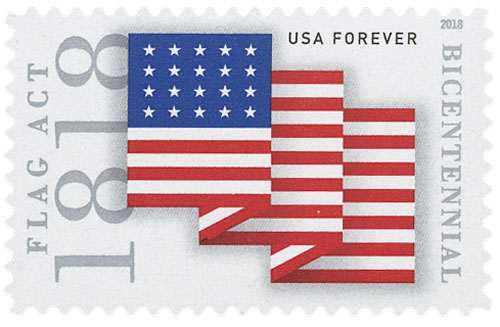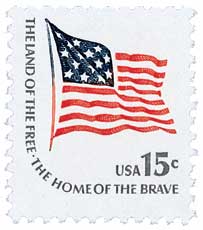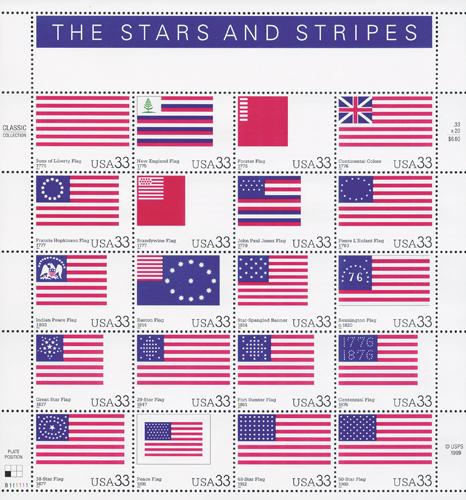
# 5284 - 2018 First-Class Forever Stamp - Flag Act of 1818
U.S. #5284
2018 50¢ Flag Act of 1818
On June 9, 2018, the USPS honored the 200th anniversary of the Flag Act of 1818. This act shaped the design of every US flag since that time.
On April 4, 1818, President James Monroe signed a flag act that changed the way the US flag was updated when new states joined the Union. This act has affected every US flag issued since… Many people claimed to have designed America’s first flag, including Betsy Ross and Francis Hopkinson. Regardless of who designed it, the Flag Resolution of 1777 declared that the flag contain 13 stars and 13 stripes, in honor of the 13 states of the Union. However, that resolution didn’t specify the arrangement of the stars, the number of points they had, or whether the flag should have seven red stripes and six white ones or vice versa. So many early flags had different variations of this design. These included some with all the stars grouped to form one larger star, all the stars in a circle, and in rows. In 1795, the number of stars and stripes was increased to 15 (to represent the admission of Vermont and Kentucky to the Union). This was the flag that flew over Fort McHenry in September 1814 and inspired Francis Scott Key’s “Star Spangled Banner.” For over 20 years, the flag was not changed when states were added to the Union due to the belief that it would be overcrowded. It was Peter Wendover, a US Congressman from New York, who recognized the need for an updated flag. The current design had 15 stars and stripes, but five more states had been added to the Union. Wendover turned to Samuel Reid, an experienced navy officer, for advice. Reid designed three flags for Wendover to present. They decided to return to the original 13 stripes and to put 20 stars on a blue field. In this way, a new star could easily be added for each new state admitted into the Union. Taking one of Reid’s designs, the “People’s Flag,” to the House, Peter Wendover encouraged his colleagues to remember the soldiers from the Revolutionary War. He stated, “In their memory, and to their honor, let us restore substantially the flag under which they conquered.” The bill passed on April 4, 1818, and was signed into law by President James Monroe. From then on, the number of states in the Union would dictate the number of stars on the flag. The change would be made official on the fourth of July following the state’s admission. That act has continued to dictate how the flag is updated ever since, with the most recent change occurring in 1960. In 2007, the 50-star flag became the longest-used flag in US history.The Flag Act of 1818






U.S. #5284
2018 50¢ Flag Act of 1818
On June 9, 2018, the USPS honored the 200th anniversary of the Flag Act of 1818. This act shaped the design of every US flag since that time.
On April 4, 1818, President James Monroe signed a flag act that changed the way the US flag was updated when new states joined the Union. This act has affected every US flag issued since… Many people claimed to have designed America’s first flag, including Betsy Ross and Francis Hopkinson. Regardless of who designed it, the Flag Resolution of 1777 declared that the flag contain 13 stars and 13 stripes, in honor of the 13 states of the Union. However, that resolution didn’t specify the arrangement of the stars, the number of points they had, or whether the flag should have seven red stripes and six white ones or vice versa. So many early flags had different variations of this design. These included some with all the stars grouped to form one larger star, all the stars in a circle, and in rows. In 1795, the number of stars and stripes was increased to 15 (to represent the admission of Vermont and Kentucky to the Union). This was the flag that flew over Fort McHenry in September 1814 and inspired Francis Scott Key’s “Star Spangled Banner.” For over 20 years, the flag was not changed when states were added to the Union due to the belief that it would be overcrowded. It was Peter Wendover, a US Congressman from New York, who recognized the need for an updated flag. The current design had 15 stars and stripes, but five more states had been added to the Union. Wendover turned to Samuel Reid, an experienced navy officer, for advice. Reid designed three flags for Wendover to present. They decided to return to the original 13 stripes and to put 20 stars on a blue field. In this way, a new star could easily be added for each new state admitted into the Union. Taking one of Reid’s designs, the “People’s Flag,” to the House, Peter Wendover encouraged his colleagues to remember the soldiers from the Revolutionary War. He stated, “In their memory, and to their honor, let us restore substantially the flag under which they conquered.” The bill passed on April 4, 1818, and was signed into law by President James Monroe. From then on, the number of states in the Union would dictate the number of stars on the flag. The change would be made official on the fourth of July following the state’s admission. That act has continued to dictate how the flag is updated ever since, with the most recent change occurring in 1960. In 2007, the 50-star flag became the longest-used flag in US history.The Flag Act of 1818
















